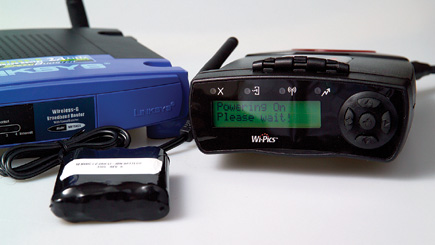Wi-Pics; Wireless Image File Transfer Page 2
What's The Diff?
If you're the owner of any EOS digital SLRs that have a DIGIC II processor
(-1Ds Mark II, -1D Mark II N, -1D Mark II, 5D, and 20D) you may be wondering
how Wi-Pics compares to Canon's WFT-E1A. Comparisons with Nikon's
WT-2 were not possible because I didn't have the technical details as
we went to press.
A basic Wi-Pics setup retails at $1700 vs. the WFT-E1A's $999. The WFT-E1A
is significantly smaller and lighter than the Wi-Pics transmitter and is attached
directly to a compatible camera, while the larger and heavier Wi-Pics transmitter
cannot be attached directly. The WFT-E1A connects to the compatible camera through
the camera's FireWire or USB interface using standard cables. It's
designed exclusively for transmitting image files from the camera to a computer
and has a 512MB internal buffer memory, whereas the Wi-Pics device can be matched
with an optional 40GB hard drive and/or removable memory cards for storage.
The bottom line is that the Wi-Pics device is compatible with almost any digital
camera--regardless of manufacturer--that has a CompactFlash card slot.
And that's a good thing.
 |
|
|
For Geeks Only?
The initial configuration of Wi-Pics requires that it be connected to your
local network (or directly to a wireless router) using a standard (Category
5) Ethernet Patch Cable connected to its Ethernet port and any available port
connected to your local network (or available port on the wireless router).
If you're not familiar with all this geeky stuff, the Wi-Pics manual suggests
that "for more information on connecting Wi-Pics to your local network,
consult your local network administrator."
More geekspeak: Both Wi-Pics and Canon's WFT-E1A are compatible with IEEE802.11b/g
(http://grouper.ieee.org/groups/802/11/)
and Ethernet, while the Wi-Pics claims compatibility with IEEE802.11a as well.
Wi-Pics Specifications
Camera Host Interface: CompactFlash Type II slot on camera
Camera Interface Cable: 5-ft camera cable included; optional
15-ft camera cable available
Wi-Pics Module: Intel XScale processor; polycarbonate construction
Weight: 20 oz with optional hard drive
Storage: Dual CompactFlash Type II slots; optional internal
20GB hard drive (hard drive storage is browser configurable for FAT 16 and FAT
32 compatible cameras)
Network: Internal 10/100MB/sec Ethernet; Conexant PRISM 802.11b/g
wireless LAN; Integrated 2dBi WLAN antenna; 17dBm maximum power output
User Interface: Remote-mountable user interface pod; 2x16 character
LCD shows status and configuration menus; five-way navigation pad for configuration;
configuration via web browser
Transfer Protocols: Image transfer via UNC (Uniform Naming
Convention) or FTP; password-protection
Wireless Security: Industry standard WEP encryption; 802.1x
EAP-TLS RADIUS certificate-based; authentication (via Microsoft ISA server)
compatible with concealed network SSIDs (Service Set Identifier)
Power: Lithium ion rechargeable battery (tested to 5+ hours),
charger, a 110-240v with power adapter
For more information, contact Dice America, 7676 Netlink Dr., Ste. A, Victor,
NY 14564; (585) 869-6200; www.wi-pics.com.
- Log in or register to post comments

































